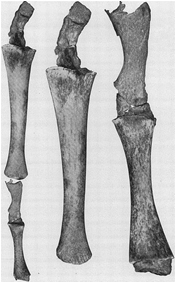
The picture above shows bones from the hind end of a humpback whale. The whale, caught in July 1919 in the Pacific Ocean, had bones that closely resembled leg bones of other mammals. The presence of these leg bones in whales suggests that whales and land mammals may have had —
A. similar diets
Incorrect. The presence of bones does not relate directly to the type of food consumed.
B. similar phenotypes
Incorrect. Phenotype is the outward expression, or appearance, of a genetic trait.
C. common appendages
Incorrect. Whale appendages are called fins while humans have arms and legs.
D. common ancestors
Correct!
Which of the following is not evidence for evolution?
A. Homologous traits
Incorrect. Similar features in different species are evidence of evolution.
B. Fossil record
Incorrect. The fossil record is evidence of evolution.
C. Energy pyramids
Correct!
D. DNA similarities
Incorrect. DNA similarities in amino acid sequencing are evidence of evolution.
Cytochrome C is a protein that is common in vertebrates. Looking at the number of differences in amino acid sequence, scientists can show the closeness of relationships between organisms. Use the chart below to determine which two organisms are the most closely related.

A. Horse and human
Incorrect. There are five differences between humans and horses.
B. Rabbit and monkey
Incorrect. There are four differences between rabbits and monkeys.
C. Monkey and human
Correct!
D. Human and chicken
Incorrect. There are seven differences between humans and chickens.
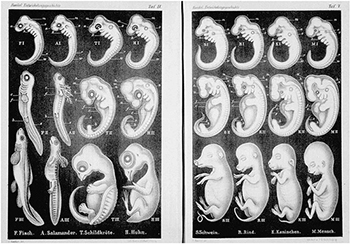
In 1874, Ernst Haeckel analyzed the embryos of vertebrates, as shown here in his drawing. Which of the following could be a valid conclusion based on his findings?
A. All organisms have the same DNA that has changed over time.
Incorrect. DNA structure is similar in organisms but the sequences are very different.
B. Vertebrates show similarities as embryos, which suggest common ancestry among organisms.
Correct!
C. Human embryos are most similar to fish and salamander embryos.
Incorrect. All of these embryos are equally similar in the early stages of life.
D. All organisms on earth have tails at some point in their development.
Incorrect. Vertebrates have tails at some point in their development but not all animals do.
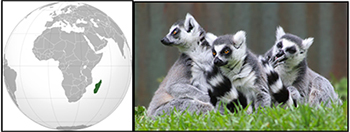
Lemurs are primates that are only found on the small island of Madagascar off the coast of Africa. There are nearly 100 species of lemurs found there and nowhere else in the wild. This evidence of evolution is called —
A. homologous traits
Incorrect. Homologous traits are traits with similar structure but different functions.
B. hiogeography
Correct!
C. lemuroidea
Incorrect. Lemuroidea is the family name for lemurs.
D. vestigial structures
Incorrect. Vestigial structures have a reduced size or function.
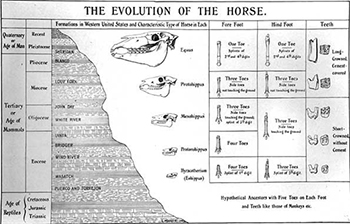
Ancient horse fossils have been found in the United States. The comparison of horse molars and number of toes present suggest that these species —
A. are not related to horses
Incorrect. It is evident that they are horse ancestors.
B. share a common ancestor
Correct!
C. are more closely related to deer than to horses
Incorrect. The fossil record shows that they are related to modern horses.
D. were most common during the Oligocene era
Incorrect. Quantities of horse ancestors are not indicated in the figure.
A beetle has a genetic mutation that gives it a longer wingspan and allows it to fly for longer distances. It is able to escape predators and can also pass the wingspan gene to its offspring. Over time, the beetle population will —
A. stay the same due to genetic selection
Incorrect. Genetic selection is not a scientific factor.
B. change into larger beetles because natural selection indicates that larger beetles live longer
Incorrect. The wingspan gene does not control size of the beetle.
C. evolve over time to have an increased frequency in the long wingspan gene
Correct!
D. not evolve since the gene for wingspan frequency cannot be inherited by future generations
Incorrect. It is indicated in the question that the wingspan gene is heritable.
Which of the following is a valid statement?
A. In order for a population to adapt, genetic variation must be present.
Correct!
B. In order for an individual to adapt, they must have genetic variation.
Incorrect. Individuals cannot adapt, only populations.
C. Individuals adapt to their environment when climate change is evident.
Incorrect. Individuals cannot adapt, only populations.
D. Populations do not adapt, only individuals can adapt.
Incorrect. Individuals cannot adapt, only populations.
According to Darwin's theory of evolution, differences between species may be the result of —
A. the disuse of body structures
Incorrect. Body structures that are disused are not passed to offspring.
B. acquired characteristics
Incorrect. Body structures and behaviors that are acquired or learned are not genetically passed to offspring and do not contribute to evolution of a species.
C. RNA transcription
Incorrect. RNA transcription is a step of protein synthesis.
D. natural selection
Correct!
Which individuals in a population are more likely to pass their genes on to a future generation?
A. Individuals who have the genes with the most mutations
Incorrect. Quantity of mutations is not a factor in reproductive success.
B. Individuals who have the best genes to survive and reproduce in their environment
Correct!
C. Individuals who adapt by choosing which traits are best to pass on to their offspring
Incorrect. Individuals cannot adapt, only populations. Also, organisms cannot choose their traits.
D. Individuals cannot pass genes on to future generations because genes are not always inheritable
Incorrect. Genes are passed from parent to offspring.
Genetic diversity among species allows —
A. evolution to take place
Incorrect. This is a valid statement but not a complete answer.
B. beneficial genes to be passed to offspring
Incorrect. This is a valid statement but not a complete answer.
C. species to thrive in changing
Incorrect. This is a valid statement but not a complete answer.
D. all of the above
Correct!
Which of the following describes a trait that increases an organism’s chance of survival?
A. Genetics
Incorrect. Genetics is the study of heredity.
B. Natural selection
Incorrect. Natural selection is a mechanism of evolution.
C. Evolution
Incorrect. Evolution means change over time and does not describe a specific trait.
D. Adaptation
Correct!

Which statement best describes what is illustrated in the picture above?
A. Natural selection has occurred changing the population phenotype.
Correct!
B. Natural selection has occurred because the bird is one of Darwin’s finches from the Galapagos Islands.
Incorrect. Darwin’s finches are not the reason for natural selection.
C. Natural selection has not occurred since the bird chose to only eat the green beetles.
Incorrect. The bird choosing to eat only green beetles is an example of natural selection.
D. The answer is not here.
Incorrect. The answer is present. Try again.
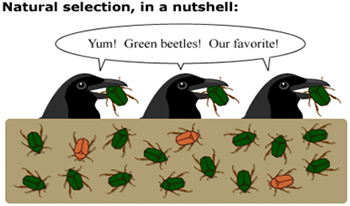
Predict what will happen to the beetle population over time.
A. The population will remain unchanged due to natural selection.
Incorrect. Natural selection will cause the population to change.
B. Natural selection will cause the brown alleles to become more common in the population.
Correct!
C. Natural selection will cause the green alleles to become more common in the population.
Incorrect. The green beetles will struggle to survive and reproduce, reducing their genes in the population.
D. The most fit will adapt and survive causing the population to remain mostly dark green.
Incorrect. While the most fit will adapt and survive, the population will shift.
Which statement below is not part of Darwin’s theory of natural selection?
A. Populations have genetic variation.
Incorrect. This is a principle of Darwin’s theory of natural selection.
B. Organisms will compete for limited resources.
Incorrect. This is a principle of Darwin’s theory of natural selection.
C. Organisms produce more offspring than can survive.
Incorrect. This is a principle of Darwin’s theory of natural selection.
D. Individuals adapt based on climate.
Correct!
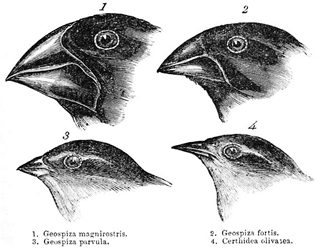
Upon returning to England, Charles Darwin noted that finch beak variation was aligned with food sources available to each species. Which of Darwin’s theories was supported by his observations?
A. Homologous traits
Incorrect. Darwin did not describe homologous traits as one of his theories.
B. Genetic variation
Incorrect. Genetic variation is a principle that supports Darwin’s theory.
C. Natural selection
Correct!
D. Food source determines genes
Incorrect. Genes are passed down from parent to offspring and are not influenced by external sources.

According to the phylogenetic tree above, which two families of lemurs are more closely related?
A. Daubentoniidae and Lemuridae
Incorrect. The branches are too far apart.
B. Daubentoniidae and Cheirogaleidae
Incorrect. The branches are too far apart.
C. Lepilemuridae and Cheirogaleidae
Correct!
D. Indriidae and Daubentoniidae
Incorrect. The branches are too far apart.
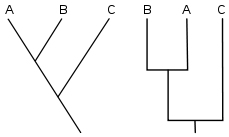
What is the main difference between the two cladograms shown above?
A. The cladogram on the left is more accurate.
Incorrect. Both Cladograms are equally accurate.
B. The cladogram on the right is more accurate.
Incorrect. Both Cladograms are equally accurate.
C. Species B and C are more closely related in the cladogram on the right.
Incorrect. Both Cladograms show the same closeness of relationship.
D. None. Both cladograms show identical relationships between the organisms.
Correct!
In the order of hierarchical classification, the level that is most inclusive is —
A. Phylum
Incorrect. There is a more inclusive group than Phylum.
B. Species
Incorrect. Species is the most specific level and does not include any other levels.
C. Genus
Incorrect. Genus only includes the species level of classification. There are more inclusive groups than Genus.
D. Kingdom
Correct!
Carolus Linnaeus described a universal naming system called binomial nomenclature. Which two levels of classification are used to determine a scientific name?
A. Kingdom and Phylum
Incorrect. These levels are too broad for scientific names.
B. Family and Species
Incorrect. Family is not used in scientific names.
C. Order and Genus
Incorrect. Order is not used in scientific names.
D. Genus and Species
Correct!

According to the chart, which two organisms are most closely related?
A. Capuchin monkey and red fox
Incorrect. Monkeys and foxes only have three levels in common.
B. Galapagos turtle and ringtail lemur
Incorrect. Turtles and lemurs only have two levels in common.
C. Red fox and Galapagos turtle
Incorrect. Foxes and turtles only have two levels in common.
D. Capuchin monkey and ringtail lemur
Correct!

According to the chart, which organism is least closely related to the others?
A. Capuchin monkey
Incorrect. Monkeys share Class Mammalia with three organisms and the Primate Order with two.
B. Galapagos turtle
Correct!
C. Ringtail lemur
Incorrect. Lemurs share Class Mammalia with three organisms and the Primate Order with two.
D. Red fox
Incorrect. Foxes share Class Mammalia with three organisms.
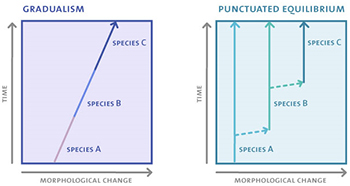
Which model illustrates long periods of stasis followed by periods of rapid change?
A. Gradualism
Incorrect. Gradualism shows slow, gradual change over time.
B. Punctuated Equilibrium
Correct!
C. Both Gradualism and Punctuated Equilibrium
Incorrect. Gradualism shows slow, gradual change over time.
D. Neither Gradualism nor Punctuated Equilibrium
Incorrect. One of these is the correct answer.
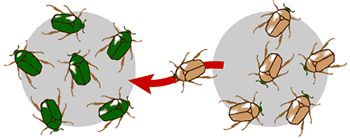
This picture is an example of the evolutionary mechanism known as —
A. genetic drift
Incorrect. Genetic drift is loss of variation due to a random chance event.
B. gene flow
Correct!
C. mutation
Incorrect. Mutations are changes in DNA sequence.
D. recombination
Incorrect. Recombination is the process when genes are split and reassembled.
Which of the following is the best description of genetic drift?
A. Individuals move to a new location by floating on debris found in an ocean current.
Incorrect. This is describing gene flow.
B. Individuals move from one population to another increasing the genetic variation in a population.
Incorrect. This is describing immigration.
C. A chance event reduces the available alleles in a population causing a decrease in genetic variation.
Correct!
D. A chance event increases the available alleles in a population causing an increase in genetic variation.
Incorrect. The chance event decreases the alleles in a population.
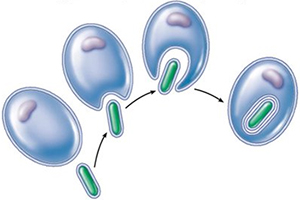
The Endosymbiosis theory, depicted above, states that —
A. larger prokaryotes engulfed smaller prokaryotic cells and this gave rise to eukaryotic cells
Correct!
B. eukaryotic cells gave rise to prokaryotic cells by a process called budding
Incorrect. Prokaryotic cells are older and therefore could not have given rise to eukaryotic cells.
C. cells diverged from one another and became prokaryotic
Incorrect. The Endosymbiosis theory describes how cells became eukaryotic, not prokaryotic.
D. none of these
Incorrect. The answer is present.
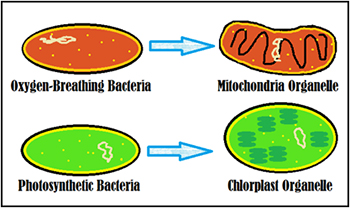
How does this picture support the Endosymbiosis theory?
A. Photosynthetic bacteria and oxygen-breathing bacteria could have been the ancestors to chloroplasts and mitochondria organelles.
Correct!
B. An organelle could have been the ancestors to photosynthetic and oxygen-breathing bacteria.
Incorrect. The arrows indicate that the bacteria gave rise to the organelles.
C. Photosynthetic bacteria and oxygen-breathing bacteria could have been the ancestors to prokaryotic cells.
Incorrect. The bacteria are prokaryotic cells. This theory is about how they gave rise to eukaryotes.
D. All of the above.
Incorrect. There is one correct answer.
Why is a standardized taxonomic system important to the scientific community?
A. The standardized taxonomic system allows scientists to better understand the kingdoms.
Incorrect. It is not limited to the kingdom level of classification.
B. The standardized taxonomic system allows scientists to further support arguments involving evolutionary theories.
Incorrect. Taxonomy is not the study of evolution.
C. The standardized taxonomic system allows scientists to study and share information about organisms no matter what language they speak.
Correct!
D. The standardized taxonomic system allows scientists to write textbooks that promote scientific thought.
Incorrect. Taxonomy is included in textbooks but that is not the purpose for it.
A student observed an organism in the lab. She noted that the organism was multicellular, eukaryotic, motile, and heterotrophic. The organism can be classified in the kingdom —
A. Protista
Incorrect. Protista are unicellular.
B. Plantae
Incorrect. Plantae are autotrophic, not heterotrophic.
C. Fungi
Incorrect. Fungi are sessile, not motile.
D. Animalia
Correct!
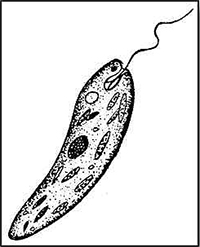
A student observed an organism in the lab. The unicellular organism can be classified in the kingdom —
A. Protista
Correct!
B. Archaebacteria
Incorrect. This organism has membrane-bound organelles and is therefore eukaryotic. Bacteria are prokaryotic.
C. Fungi
Incorrect. The flagellum indicates that this organism is motile. Fungi are sessile.
D. Eubacteria
Incorrect. This organism has membrane-bound organelles and is therefore eukaryotic. Bacteria are prokaryotic.